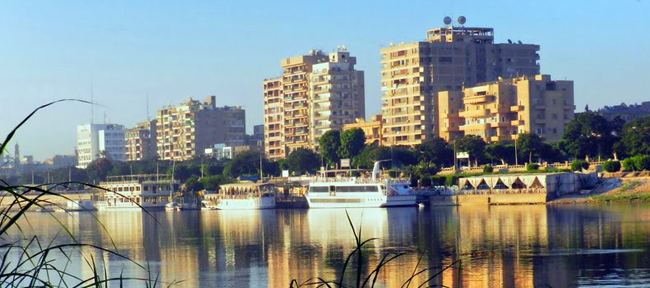Country Egypt Time zone EET (UTC+2) Area 32,279 km² | Website Minia Population 5.004 million (2014) University Minya University | |
 | ||
Minya Governorate (Arabic: محافظة المنيا Muḥāfẓet El Minya) is one of the governorates of Upper Egypt. Its capital city, Minya is located on the left bank of the Nile River.
Contents
- Map of Menia Governorate Egypt
- Etymology
- Population
- Cities
- History
- Ancient Egyptian period
- Greco Roman period
- Byzantine period
- Arab period
- Modern history
- Projects
- National holiday
- Industrial zones
- Agriculture and industry
- Important sites
- Monasteries in the Minya Governorate
- Notable people
- Statistics
- References
Map of Menia Governorate, Egypt
Etymology
The name originates from the chief city of the governorate, originally known in Sahidic Coptic as Tmoone and in Bohairic as Thmonē, meaning “the residence”, in reference to a monastery formerly in the area. The name may also originate from the city's name in Egyptian Men'at Khufu.
Population
According to population estimates from 2015 the majority of residents in the governorate live in rural areas, with an urbanization rate of only 18.9%. Out of an estimated 5,156,702 people residing in the governorate, 4,183,284 people live in rural areas as opposed to only 973,418 in urban areas.
Cities
The capital of Minya governorate is the city of Minya. The governorate is one of the most highly populated governorates of Upper Egypt. It contains nine cities; 3,375 villages; and 10,875 hamlets, within the following nine boroughs, from north to south:
The following cities are located in this governorate:
History
Little is known today about Minya Governorate compared to its great wealth of important archaeological sites. Its remarkable history, including Ancient Egyptian, Hellenistic, Roman and Arab periods, has not yet received the full attention of scholars.
Ancient Egyptian period
Dehnet, Fraser Tombs, Sharuna, and Zawyet el-Maiyitin comprise monuments dating back to the Old Kingdom.
The village of Bani Hasan al Shurruq houses 390 rock-cut decorated tombs and chapels from the Middle Kingdom (2000–1580 BC, especially the sixteenth dynasty). The Speos Artemidos is nearby, and hosts temples built by Queen Hatshepsut.
Akhetaten was built by Pharaoh Akhenaten and dedicated to the god Aten. Akhenaten lived there in isolation with his beautiful wife, Nefertiti, and daughters, devoting himself to the monotheistic religion that he preached. The glorious remains of the palaces, temples and tombs still exist today.
Other significant archaeological sites in the governorate of Minya include Deir Abu Hinis, Deir el-Bersha, El-Sheikh Sa'id, and Tuna el-Gebel.
Greco-Roman period
El Ashmunein (Hermopolis Magna) was the capital of the region during this period. It was the main center of worship of the god Thoth. Today, the ruins of a Greek temple, similar to the Parthenon, can be still found.
The tomb and chapel of Petosiris are found near the modern village of Tuna el-Gebel.
Antinopolis was built in 130 A.D. by the Roman emperor Hadrian in memory of his favorite cup-bearer Antinous.
Byzantine period
The Monastery of the Virgin Mary at Gebel el-Teir is an important Christian site near the city of Samalut. Its church was built by Empress Helena, mother of Constantine the Great, in 328, on one of the sites where the Holy Family is believed to have stayed during its Flight into Egypt.
Oxyrhynchus was an important administrative center during the Hellenistic Period, and remains an important archaeological source for papyri from the Byzantine Egypt.
Arab period
Maghagha hosts the mosque of the famous Muslim Zayid ibn al Mugharah.
Modern history
Today, Minya governorate has the highest concentration of Coptic Christians of 50% of the total population. There are also a number of active monasteries in the region.
Projects
In 1981, the Basic Village Service Program (BVS) of USAID, had several water, and road projects, going on in several markazes in the Minya Governorate. In 2013, The United Nations Trust Fund for Human Security helped farmers in Minya by doing consultation work with them and taking soil samples.
National holiday
The national holiday of the Minya governorate is on 18 March. It commemorates those who were executed by the British at Deir Mawas on 18 March 1919.
Industrial zones
According to the Egyptian Governing Authority for Investment and Free Zones (GAFI), in affiliation with the Ministry of Investment (MOI), the following industrial zones are located in this governorate:
Agriculture and industry
Minya Governorate is an important agricultural and industrial region. Among its principal crops are sugarcane, cotton, beans, soybeans, garlic, onions, vegetables of various sorts, tomatoes, potatoes, watermelons, and grapes. Among the leading local industries are food processing (especially sugar and the drying and grinding of onions), spinning and weaving of cotton, perfumes, oils and fats, cement-making, quarrying (especially limestone), and brick-making.
